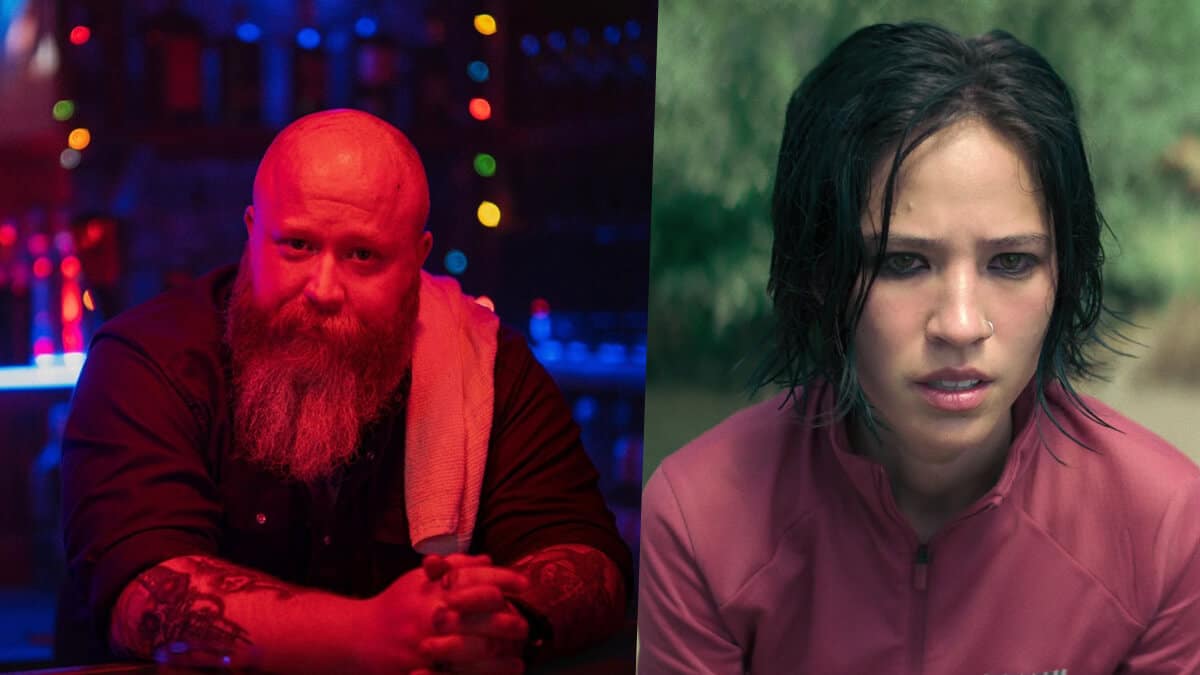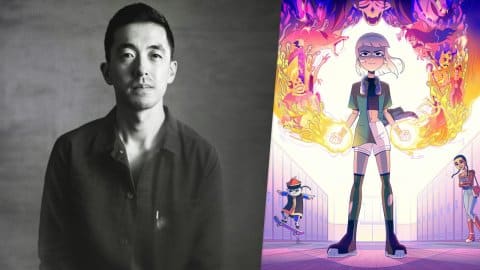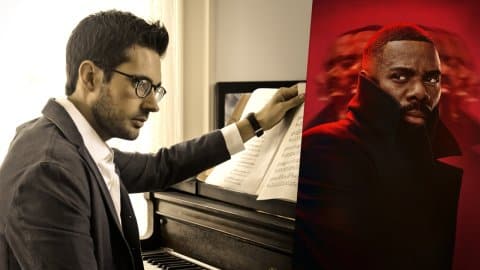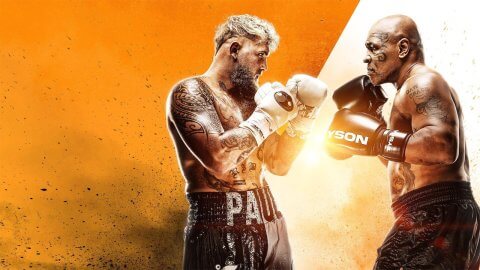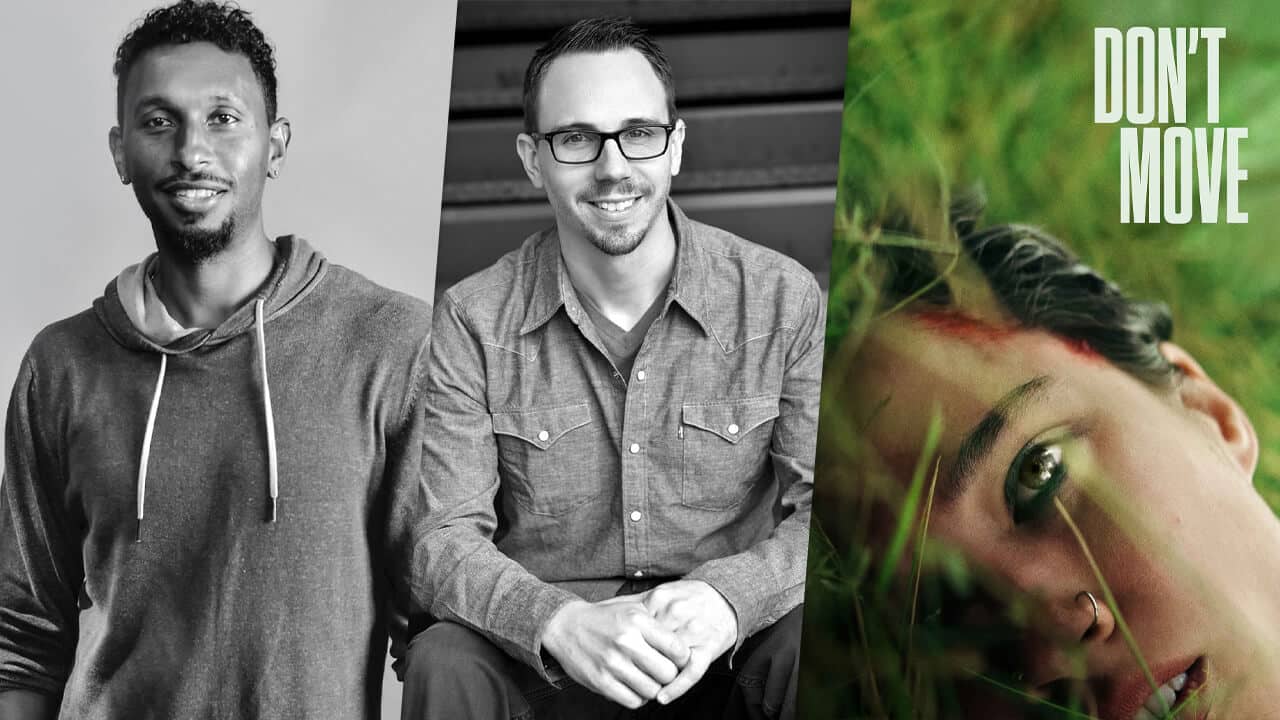
Picture: Brian Netto (left) and Adam Schindler (right), the directors of Don’t Move
Netflix’s new horror thriller, Don’t Move, will be available on October 24th, 2024. Recently, we had the pleasure of discussing the movie with directors Brian Netto and Adam Schindler.
Don’t Move is a new horror thriller co-directed and created by Brian Netto and Adam Schindler. It is written by T.J. Cimfel and David White. Hammerstone Studios produces the film, and Sam Raimi serves as an executive producer.
Iris, a woman suffering from grief, has a chance encounter in the woods that leaves her temporarily paralyzed after being injected with a paralytic agent. As her body begins to shut down nearly all bodily functions, Iris must somehow find a way to run, hide or fight to survive.
Jacob: How did you first become involved with Don’t Move?
Adam: Well, Don’t Move was an idea that Brian and I came up with several years ago. We asked ourselves, “Can you make a movie that has somebody paralyzed for a majority or significant portion of it?” We tossed around the idea between ourselves before pitching it to the writers T.J. and David, both fantastic writers and good friends of ours.
They wrote our film before this one, Intruders. I want to call it Shut In because that’s what it was originally called. But they wrote Intruders, and they’ve become good, you know, co-workers and friends, and so we pitched them this idea.
Then, during the pandemic, from the middle to later parts of it, when everybody was home, we just had meetings like this.
Four boxes and four faces just beat out how this would work. What’s the story? What’s the character that fits into this kind of concept? We knew it was going to be a genre exercise. We knew it would have a bunch of these sequences that would make it fun and thrilling. But what character kind of fits into that? What makes sense for that? And how do you pull emotion out of that? Once we settled on everything, the boys went away and turned in the draft of the movie that everybody will see in October.
Brian: Yeah, it all happened quickly. It took us a while to figure out the best character and antagonist for this character in this situation. But then, once they went away and wrote, they probably started writing in the fall. I think by spring, we had gone out with the script. It came along pretty quickly. We brought it to Sam [Raimi], and we had experience with him on a show that we did, an anthology horror show that we worked with him on that he executive produced. And so when he came aboard, everything started moving quickly.
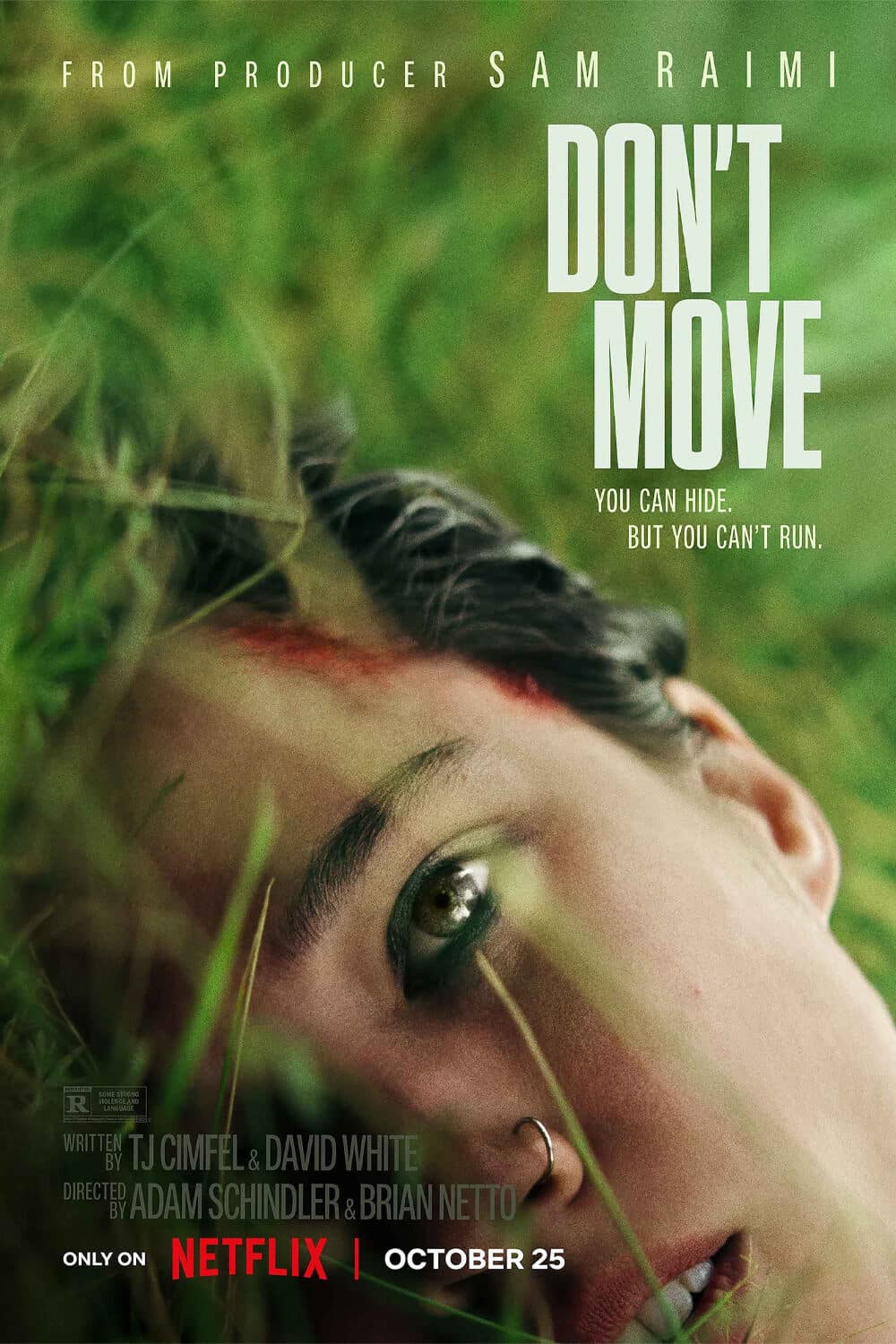
Jacob: What was it like working with Sam Raimi? Did he have much involvement in the production?
Brian: Our previous working experience with him on Fifty States of Fright was nine different episodes, meaning nine creators. It’s like trying to give all your kids attention. He was also involved in that, but he also directed an episode.
So, we had a chance to go through the script with him and had great questions. His process is that he actually goes through a script reading. So we read the script with him, and he stops and asks you questions and tries to figure it out. These questions are great not just on the page but also when he’s thinking far out on the day, in production, and about editing.
Obviously, he’s been doing this for quite some time, so that was a great process on Fifty States. It was so much more intensive, though, on Don’t Move because we just had so much more of his time. And so he was involved anytime we needed him. It was always like, “Pick up the bat from him if we need Sam.” And that was great. We wanted to make sure that we only utilized him whenever we needed him, but he was so supportive.
He gets excited and nervous for you, but he’s just as invested in it as if it were his. I mean, it is his film. His name is on it. So he wants to make sure it’s the best it can be, but he gets just as into it as if it were his baby. And that’s the best thing about working with Sam, aside from the talent and the fact that his films have influenced us. It’s the fact that he cares as much as he does, and it shows, and he lives and dies with it just like you do, which is something we’ve never experienced.
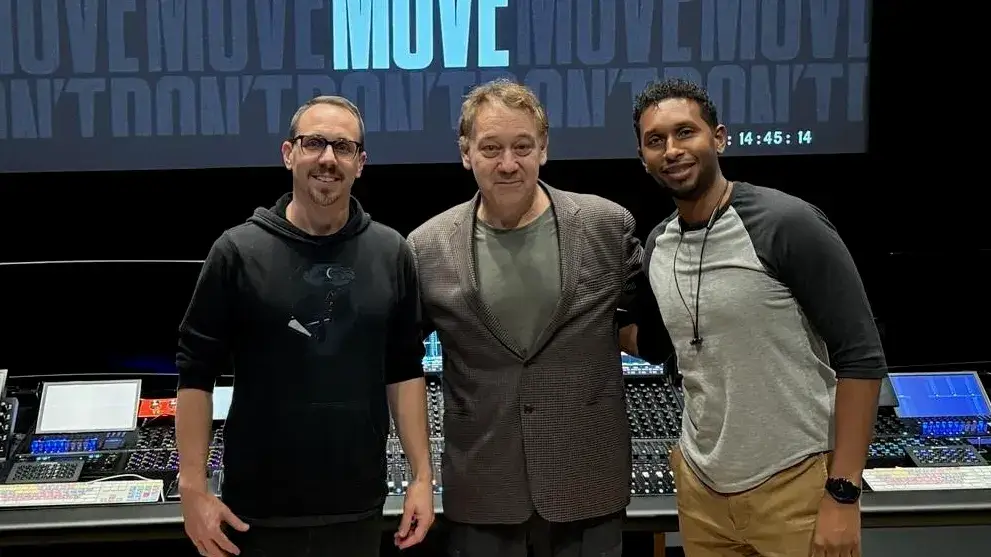
Pictured left to right: Adam Schindler, Sam Raimi and Brian Netto
Adam: He’s the biggest cheerleader and fanboy, but then he’s also the smartest, like Brian was saying, the smartest when it comes to notes from script to screen, you know, what the audience, like what is written here, how we plan to do it, and then what effect are we trying to get the audience to feel ultimately. And his notes just kind of cut through all of that. So he was on set for some of the shoot in Bulgaria.
Brian: This was the first time he’d been on set for one of the films he had done with Raimi Productions. Raimi Productions is a newer end. Ghost House has been around longer, but Raimi Productions is newer. And he hadn’t been because of other, you know, the pandemic and he was making Doctor Strange. So everyone was excited that he was going to be there. And it was such a treat to have him there with us for a few days. It was great.
Adam: Yeah, cheering you on and giving you a thumbs up when he’s liking stuff.
Jacob: What sort of challenges did you face filming in Bulgaria? You would have been at the center of the writer’s strike during that period. So, when it came to any decisions that needed to be made, were you able to make those creative changes to the story?
Brian: I’ll start with the physical, just being in the woods at the mercy of the weather. That was the biggest challenge initially. And then I’ll talk strikes and stuff as well. But that would be the biggest challenge, which was just your outdoors. This is a film in which the good majority of it takes place outdoors. There are some sequences inside, so we were at the mercy of that.
It takes place over the course of the day. We wanted to make sure that continuity is always an issue. So those are the sorts of things inherent to any production. You’re always going to be dealing with that. It is cooperation from the weather. You were making sure that you could make your days. Those are the different things you’ll always face and be faced with every other film. This film had a unique situation where we had three different strikes happening, and they all lined up one after another. And it just so happens that in our production, we had locked our script, and then the writer’s strike hit. So we were fortunate in that respect.
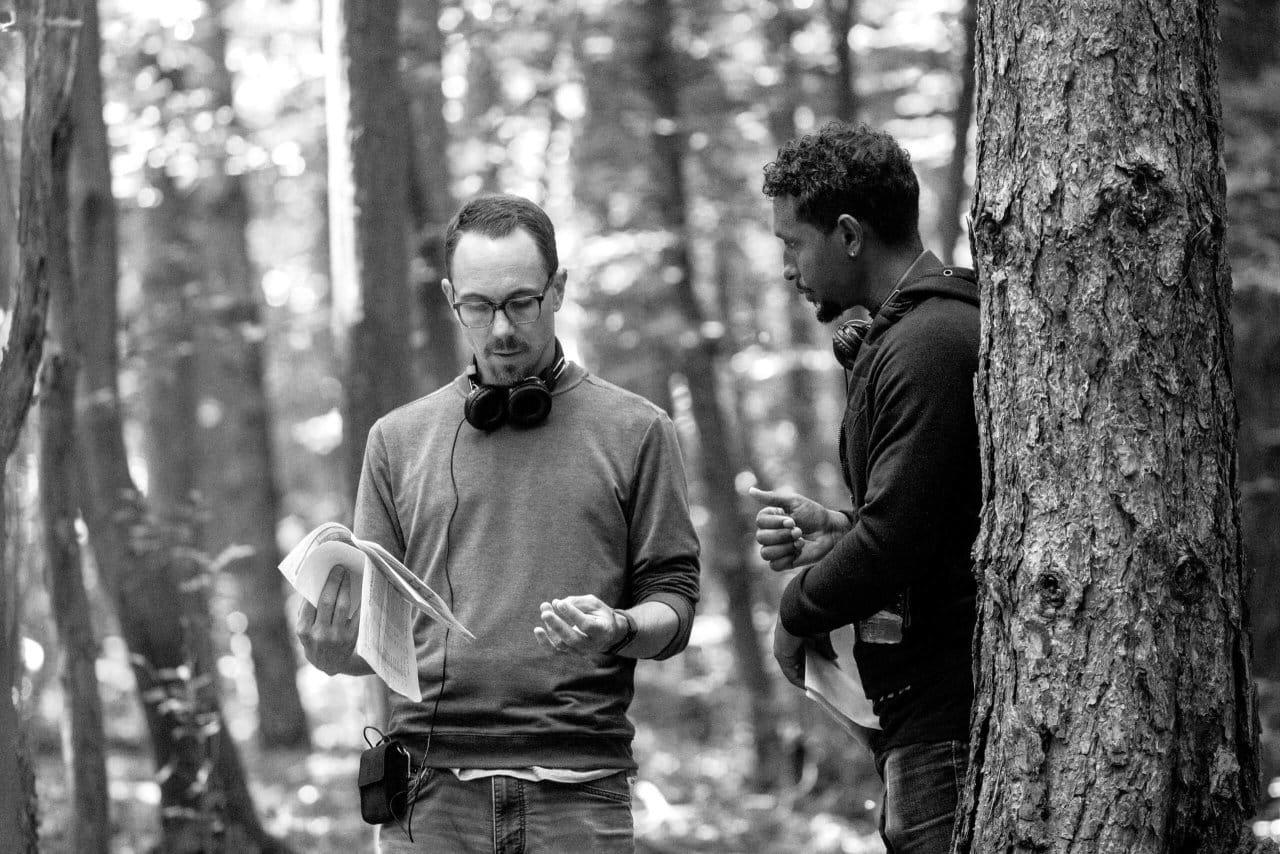
DON’T MOVE. BTS – (L to R) Co-Directors Adam Schindler and Brian Netto on the set of Don’t Move. Cr. Vladislav Lepoev/Netflix © 2024.
Adam: Before we move on, just regarding the writer’s strike, we have such a good relationship with T.J. and Dave, and it was a grassroots effort to create this story.
Don’t Move was like all our babies. We talked a lot about potential roadblocks. So, we had different versions of scenes and situations that we had discussed at length with them. But we never really had to include any of those extra scenes. We were pretty locked in, as this is a linear movie.
There are not any sub-characters you can cut out of this. So it’s like one scene moves to the next thing to the next thing to the next. So, in that case, it was kind of like we were protected from having to go in there and do major script revisions on day 20.
Brian: Yeah. And then the director’s guild strike came and went, and keep in mind when you’re in another country halfway across the world, for us, a lot of that stuff is background noise because you’re just so focused on prep, and then in some cases filming.
Then the actor strike happened, and we had five days left of filming after the strike had hit, but we were one of the three productions that initially got a waiver. I think it was Shyamalan’s daughter’s film The Watchers that he produced. That film, I think it was us two and maybe a third one, got a waiver immediately. And so we were able to continue and finish our film.
But part of the reason we went when we did, right? Had we not gone right when we did, we knew we would run into an issue that should the strikes happen, the director’s strike happen, and the director’s guild strike and the SAG strike happen, we would be protected. If it got to that point, we’d have a few more days and the waiver to get there.
So it was a lot of blocking out all these things you can’t control and focusing on what you can. And that’s basically every day of filmmaking. So I think we were very fortunate that we had a film that was near completion and ultimately completed at a time when a lot of people weren’t working, which is great for that.
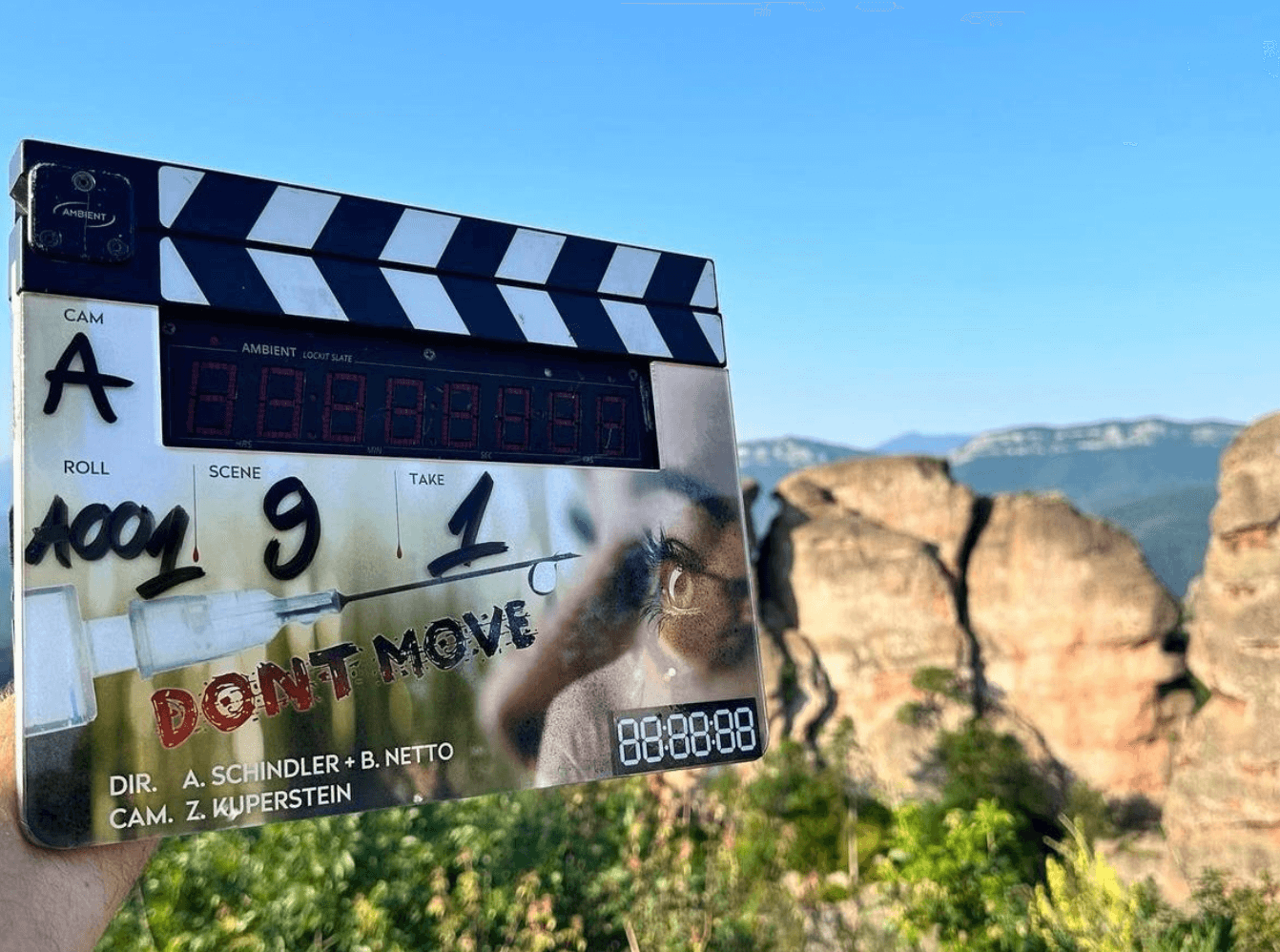
Picture: Behind-the-scenes of Don’t Move – Netflix
Jacob: What sort of training or choreography did you have Kelsey go through to bring that performance from her?
Adam: The training was trust-based for her; at least she trusted us to let her know if there was too much movement. She met with an anesthesiologist. We talked about how this would feel and really discussed flag points in the script. This is where you’re at physically. This is what you can do, what you can move, what you can do at this point. And we did that kind of through the entire script so that when we were on the day, she didn’t have to think about where she was at. Like, oh, can I move my fingers in this part? We all had that planned out.
So she knew exactly where she was, like her ability to move. And then it was up to her to trust us to say, yeah, your cheek twitched a little bit there that you can’t do that. And it sounds funny, but it comes down to that minute, and luckily, there are two of us. We’re both looking at different parts and trying to make sure that her leg didn’t move here and this and that.
That was the most challenging part. It’s just kind of whatever, and she’s so expressive. She’s so great, and she’s so expressive with her eyes, and you know, that’s something you can’t really teach somebody to be able to experience something and see that in somebody’s eyes. Not even their face, but their eyes. So we really lucked out, and Kelsey did a bang-up job with that.
A lot of the movie hinges on her performance in the eyes. Lots of close-ups of that and that kind of thing. It was mostly her trusting that we would tell her if she made too many movements.
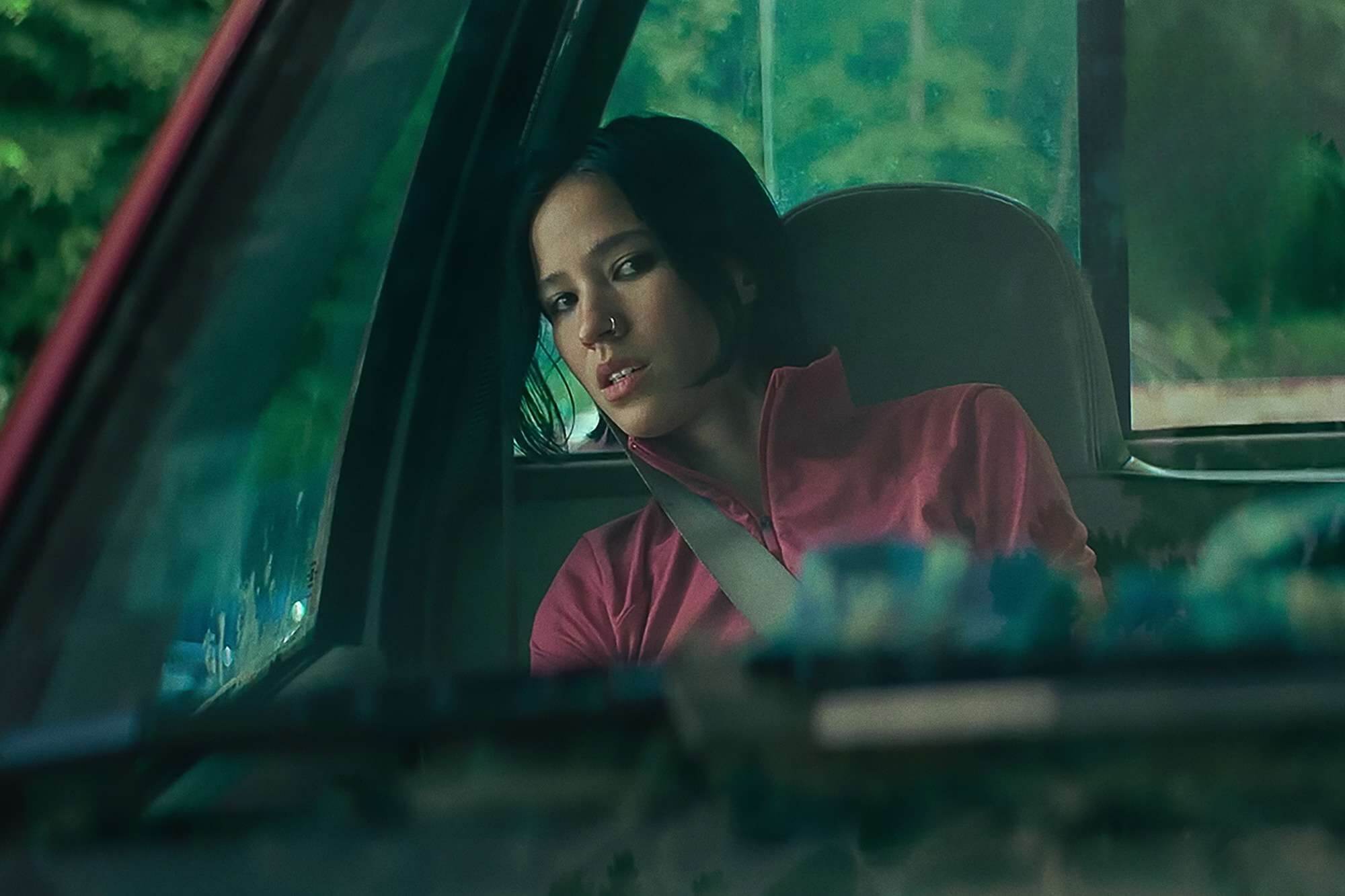
Picture: Kelsey Asbille in Don’t Move – Hammerstone Studios. -Netflix
Jacob: I feel for what Kelsey was unable to do physically and vocally, Finn brings double that in his performance.
Brian: Yeah, we always thought that the attraction to playing the Irish character would be the physical challenge. You have to do a lot without showing through a little. And Finn would be the person who would have to, in a lot of ways, carry us through the moments when Kelsey is immobile and unable to speak. For Finn, we thought it would be a fun challenge for someone, and it seemed as though he was also understated. Understated within the film. It is a pretty grounded film. He did a fantastic job. He had fun doing it, and we loved watching him work.
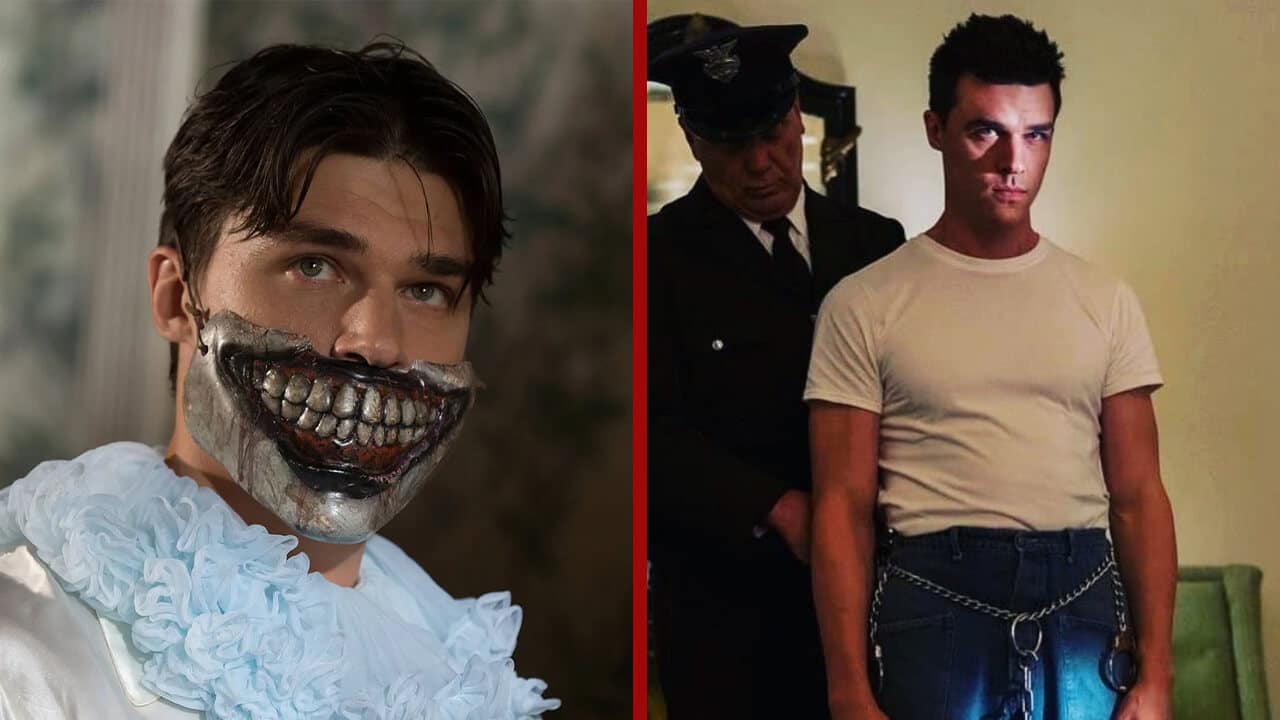
Picture: Finn Wittrock in American Horror Story (left) and Ratched (right) – FX Network / Netflix.
Jacob: I felt with Finn’s character, his impulsiveness was his greatest strength and weakness.
Brian: Absolutely.
Jacob: I felt that’s what grounded the movie. I won’t go into spoilers, but the mistakes made by Finn’s character felt natural and not over the top like you would get in some movies.
Adam: We spent a lot of time on sequences that revolved around believability because we knew that was the crux of everything. If there’s a moment that you go, eh, that feels a little movie-ish, it can ruin the entire thing because it’s the cop sequence and stuff, not getting into spoilers and this and that, but that was a scene that we spent a lot of time on the page talking about and in the edit, talking about what makes sense. How engaged is he?
How concerned is he, the cop specifically? What, do you walk away? What, do you not walk away? A lot of that kind of stuff. A lot of that hinges. I’m glad you picked up on that because we spent a lot of time crafting it and paying attention to it.
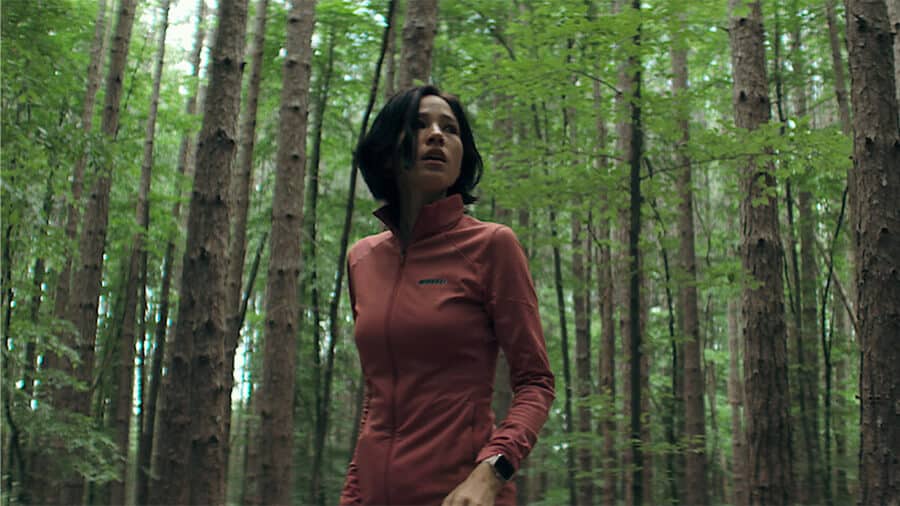
Picture: Kelsey Asbille in Don’t Move – Hammerstone Studios / Netflix
Jacob: You can plan for everything, but anything can happen when a little hint of chaos is thrown into the mix.
Brian: The thing is, you don’t know how many times he’s done this before, and he is pretty adept at rolling with the punches, but I think the point of this whole story is that she is equally proficient. She is his greatest challenge. Some parts of that are exciting because, oh, this is different, and I’m handling it, but the other part is the frustration. In that way, some of my favorite scenes are when they’re just going at each other, almost like a dark version of a bad marriage, where you see them poking at each other because they’re trying to find each other’s weaknesses.
She’s immobile. That’s her biggest issue now, but for her, she’s trying to poke around and go, how can I find a way in? That’s some of the most fun stuff in it. Because of that, because to your point, we do keep it grounded. That feels like what David and T.J. excel at. They excel at finding character moments within a great genre premise. We love the idea of them spending as much time together as possible because it is a smaller cast, and you have this great hook.
Let’s make sure that the characters are layered and interesting. The more time you spend with them, the more you learn with them in every scene. You’re learning what makes them tick. You’re learning their backstory. You’re learning just how they operate in situations like this. Also, with her, you’re watching this fire that was snuffed out when we first met her start to grow.
That’s what we enjoy. To your point, we kept it so much more based on the character because we got excited about that. We just wanted to see two actors joust with each other. We were fortunate that the two we picked did a great job.
Jacob: With the growing number of sensory horror movies, did you draw inspiration from them for Don’t Move?
Brian: It’s funny because to answer your question, no. With respect to when we started talking about all the films you’re going to talk about, Don’t Breathe is a film we absolutely love. Love Don’t Breathe. That’s the antagonist that has that particular affliction.
We did start talking about it because we wanted this to be an experiential film. We wanted you to understand without going into her head, either through voiceover or spending too much time. We wanted you to feel trapped like she did. So we started referencing films like Don’t Breathe and Waiting Until Dark. We started talking about another one, Blink, a movie from the 90s, an entertaining kind of high-concept film. We just loved the concept. Then, we built it out from there.
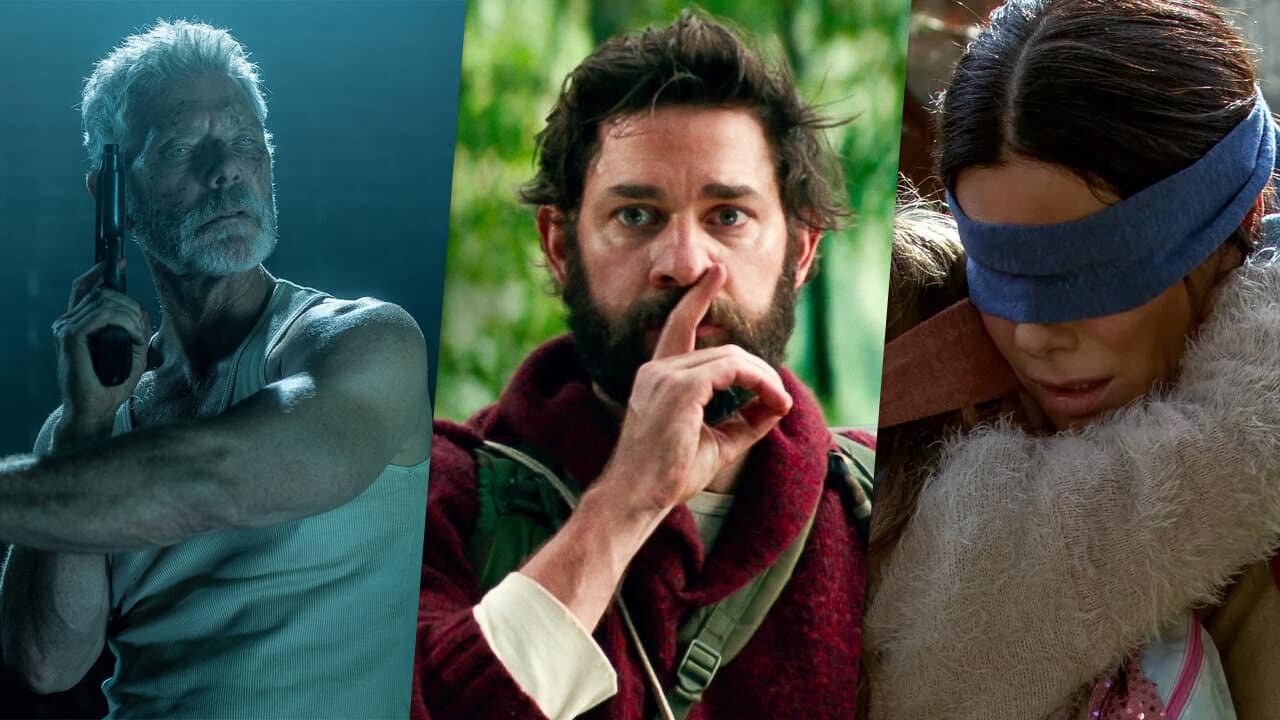
Pictured: Don’t Breathe, A Quiet Place, and Bird Box are popular sensory horror movies in recent years.
Adam: It’s universal. Just the idea of being immobile is a universal fear. And claustrophobia. It also juxtaposes that with this beautiful locale. Another fun part was figuring out that this terrible event happened in this most beautiful place. And that’s the point. You know what I mean? That was the fun of it.
How do you craft these sequences that are terrifying, suspenseful, and thrilling but set in the middle of the day in a beautiful lush forest with a river and a stream? We had a lot of fun working with T.J. and Dave, crafting those sequences, and figuring it out.
Brian: The other one I could not recall then was A Quiet Place, which also deals with the senses. But more than anything, I think we were probably more inspired by filmmakers than specific films because, you know, obviously Hitchcock, De Palma probably the most just how he builds his sequences. His set pieces are just exquisite, and they’re incredible. And then Shyamalan, but those are I think the filmmakers that we… They always had high-concept, fun thrillers. So I think more than anything, I think we just were like, oh, this will be in the vein of those filmmakers we buy. So we hoped to say we love those sorts of films without doing what they do; this is our version.
Jacob: To return to what Adam said before, while I was watching the film, I’d never felt so claustrophobic in such a green and open space.
Adam: And we accomplished our goal because that was the ultimate goal. That was what Brian was talking about. The experiential portion of the movie is that we don’t want to go into her head and start hearing her thoughts because that becomes a particular thing. We tried to make everybody feel paralyzed and be with her.
So it’s a lot of from her perspective, not necessarily her POV, but her perspective, and then giving her the whole bill thing in the middle of the movie when she’s immobile is giving her, trying to figure out okay, how do you do that when somebody is immobile?
The main character is just not moving. Give her an avatar. What’s that avatar? How do you continue building the character and arc when you pass the torch off to another character? So it was the fun of trying to craft all that and figure out how to continue her story arc when she can’t speak or move.
Brian: And it was also the sound, the conversation we had with the sound design, but also with Mark Corbin and Michelle Oshist, who did the score. Mark is great at creating both of them, sorry. They are both great at creating sounds that you can’t tell if it’s sound design or score.
It sometimes blends. We love being in the woods and being in that environment that when the drug hits all of a sudden, it starts to turn into something beautiful, the environment, to something that feels horrific. They took to that idea, and so we love playing with these sounds that they’ve been able to kind of twist and warp, and then obviously, as the drug hits, it’s now this, you know, this frightening experience, and so we had fun with that as well. So, great collaborators could take that idea and put it on screen.
Jacob: So what’s next for you both after Don’t Move? Are there any exciting projects you’re working on?
Adam: Have a couple, yeah. Yeah, we have a number of things. We have a science fiction horror script that we wrote that’s with West Fall’s company that we’re out trying to put together. As things go, it’s hard to get movies made, and it’s a long process, but that’s what we’re excited about. We have a couple of other projects, but yeah, we’re always creating. So we’re constantly drumming up ideas. We’re hoping to work with T.J. and David again on another script.
Brian: We have a pair of projects with Sam that we’re excited about, so we’ll see which one goes first. But yeah, it is very much in the genre space. We love genre. We’ll stay in genre, but we may attack it from a science fiction angle, a thriller, or a crime angle. It’s a place we love and will probably remain for quite some time.
Jacob: Are there any genres or sub-genres that you’ve got a really fun idea for?
Brian: I think Adam and I have two different ideas but we would obviously do them together. I know we had this conversation before, Adam. What were you going to say? Like an end-of-the-world movie?
Adam: Yeah, I love apocalyptic. You know, like The Day After Tomorrow, I know they can be cheesy and this and that, but there’s just something about them that I always like. Man, an apocalypse movie would be like that, but I think a grounded apocalypse; I’m not saying we have anything planned, but a grounded apocalyptic movie, you know, would be fun.
Brian: Yeah, I grew up a huge fan of martial arts films, samurai films, and ninja films, so if there were a way to do that in a unique setting, maybe a more contemporary setting, but making it make sense, that would be a blast.
Adam: Breaking news! An apocalyptic samurai movie.
Jacob: With disaster movies, it’s either a huge focus on your big budget, like buildings collapsing, mountains collapsing, or it’s about the human element.
Brian: I mean, the project we have, the sci-fi horror at West Falls Company, takes place during a big event, so it has aspects of that. To your point, it’s all about finding; I mean, I think A Quiet Place is the perfect example of a huge event but with a narrow scope, even the most recent one. It does a great job of showcasing the characters and the people within this grander event, and I think that’s the stuff we tend to gravitate towards. It’ll always be character-based. But yeah, it’d be cool to find a fun way into something like that.
Make sure to watch Don’t Move on Netflix when it arrives on October 25th, 2024! Let us know what you think in the comments below!

